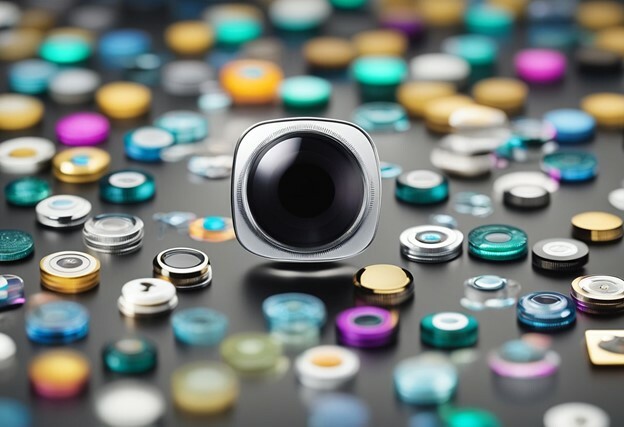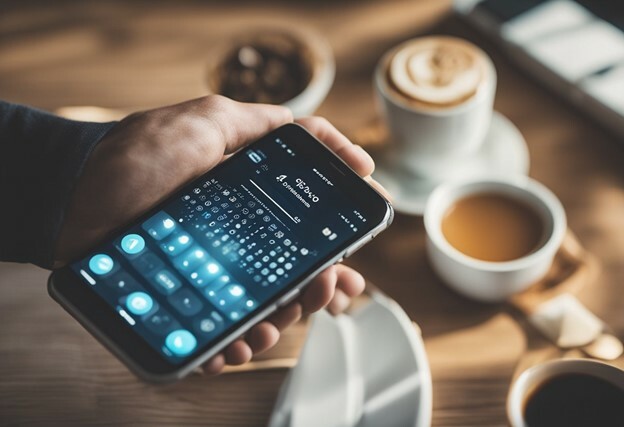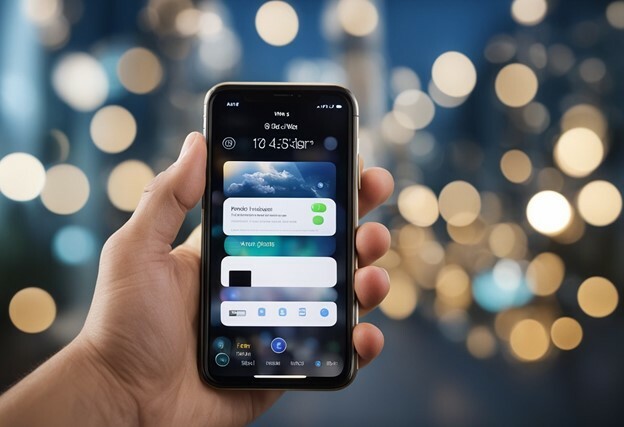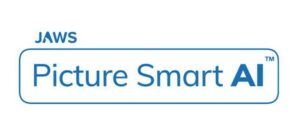Making Tech Accessible: 10 Best iOS Apps for Low Vision Users

At New England Low Vision and Blindness, our mission is to bring hope and improve the quality of life for people with low vision. As the leading provider of assistive technology and training for those who are visually impaired, we pride ourselves on staying current with the latest advancements in the field. With the world becoming more digital every day, we are excited to share our list of the top 10 iOS apps specifically designed to make technology accessible for people with low vision.
These apps provide a range of enhancements and tools to help individuals with visual impairments navigate and interact with their devices more easily. From magnifying text to improving contrast, these apps have been carefully chosen to address various accessibility needs. By leveraging the power of the latest technology, we are confident that these apps will empower users with low vision to live more independently and have an improved experience while using their devices.
In this article, we will discuss each app in detail, highlighting its key features and how it benefits users with low vision. Our goal is to provide a comprehensive guide that can help our clients make informed decisions when selecting the technology that best suits their needs. Stay tuned as we explore the world of accessible iOS apps for people with low vision.
Understanding Low Vision
 Understanding low vision is the first step in addressing the unique needs of individuals facing vision challenges.
Understanding low vision is the first step in addressing the unique needs of individuals facing vision challenges.
Low vision is a visual impairment that cannot be corrected with standard eyeglasses, contact lenses, medication, or surgery. It interferes with a person’s ability to perform everyday activities such as reading, writing, driving, or recognizing faces. Low vision can result from several factors, including age-related macular degeneration, diabetic retinopathy, glaucoma, and cataracts.
To help those with low vision, there are a range of top iOS apps specifically designed to cater to their needs. These accessible apps provide varying levels of support, including text-to-speech, magnification, and high-contrast interfaces. As the leading assistive technology provider and trainer for those with visual impairments, we strive to bring hope and independence through leading-edge technology.
Some of the top iOS apps for low vision include:
- VoiceOver
- Zoom
- Magnifier
- Siri
- Voice Dream Reader
- Be My Eyes
- Seeing AI
- KNFB Reader
- TapTapSee
- Tint Vision
Role of Tech in Accessibility

In recent years, technology has played a significant role in providing a more inclusive world for people with low vision. We, at New England Low Vision and Blindness, understand the importance of accessibility and consistently strive to make advancements in assistive technology. Our mission has always been to bring hope to people with visual impairments through life-changing resources.
The iOS apps previously mentioned cater to the specific needs of people with low vision. These apps not only improve day-to-day life, but also empower them to remain independent and confident. Some popular options include magnification apps, text-to-speech software, and navigation tools, all designed with a focus on accessibility and ease of use.
The rapid development of technology has made it possible for us to provide cost-effective solutions for our clients. From wearables to smartphone apps, these advancements in assistive technology have revolutionized the way people with low vision interact with the world around them. The top 10 iOS apps that we recommend encompass a variety of functionalities, including:
- Magnification: Digital magnifiers are essential tools for those with low vision, allowing them to see detailed information and images.
- Text-to-speech: These apps convert textual content into speech, making it easier to access information and communicate effectively.
- Navigation: GPS-based applications specifically designed for people with low vision empower them to navigate independently and confidently.
We are proud to be a leading assistive technology provider and trainer for those who are visually impaired. Our constant pursuit of innovative products and services ensures that we stay ahead of the curve in assisting with daily challenges faced by people with low vision.
Advancements in Apple Accessibility

Over the years, Apple has shown a significant dedication in making their technology accessible to everyone, including people with low vision. As a leading assistive technology provider and trainer for people who are visually impaired, we at New England Low Vision and Blindness have witnessed firsthand the life-changing impact of Apple’s advancements in accessibility.
One major development by Apple is the implementation of various built-in features for enhancing the user experience of those with low vision. Among these features are:
- VoiceOver: A screen reader that can assist users by audibly describing what’s on the screen, allowing them to interact with elements using gestures.
- Zoom: A full-screen magnifier that users can activate with just a triple tap on the screen. This tool provides customizable magnification levels, as well as the ability to change color and contrast for improved readability.
- Siri: Apple’s personal assistant, which allows users to ask questions, send messages, and launch apps using just their voice, reducing the need for visual input.
- Dynamic Type: This feature enables users to adjust the size of text across various apps and make it more legible based on their preferences.
In addition to these built-in features, there is a wide range of third-party iOS apps designed specifically for people with low vision. Some popular options for low vision users include:
- Seeing AI: An app that uses artificial intelligence to audibly describe images, recognize text, and identify objects in real time.
- Magnifying Glass with Light: A digital magnifying glass app with customizable zoom levels and built-in light for improved visibility.
- TapTapSee: A camera app that provides detailed descriptions of objects and scenes, even when the user is not aware of what exactly is in front of the camera.
- KNFB Reader: Converts printed text into speech or Braille for low vision or blind users, offering a convenient solution for reading printed material.
- Aipoly Vision: An object and color recognition app that helps users identify items they encounter in daily life.
These advancements by Apple, combined with the various third-party apps, have transformed the experience of people with low vision and made the iOS platform more accessible than ever before. By bringing hope through these life-changing resources, we are proud to help improve the lives of those who are visually impaired.
Principles of App Design for Low Vision
As the leading assistive technology provider and assistive technology trainer for people who are visually impaired, we understand the importance of making tech accessible. In our efforts to bring hope and life-changing resources to those with low vision, we’ve identified key principles that contribute to successful app design for low vision users.
One principle is simplicity. It’s crucial to avoid cluttered interfaces and unnecessary features. By keeping the design minimalistic, buttons and functions are larger, making them more prominent and easier to use. This reduces the cognitive load on the user and allows for a more intuitive experience.
Another principle is flexible font and contrast options. Different users have various preferences for font size, type, and background contrast. Apps should provide options to adjust these settings, so the user can personalize their experience to their visual needs. Features such as text-to-speech can also further enhance the app’s user-friendliness.
Clear navigation and structure plays a major role in an accessible app. Users with low vision need a consistent layout with straightforward navigation. This can be achieved by using concise headings, providing logical grouping of functions, and making it easy to go back or undo actions.
Adding customizable audio feedback can also be beneficial. Audio cues can help navigate the app, highlight important information, or provide reassurance that a desired action has been performed. Ensuring that these cues can be toggled on or off and adjusted for volume levels provides flexibility for a diverse range of users.
Lastly, gesture-based interaction can greatly improve the usability of an app. Swiping and tapping gestures can be combined with voice guidance or haptic feedback to create a more interactive and immersive experience. This can help users with low vision quickly acclimate to the app’s interface.
By incorporating these principles into app design, developers can create more inclusive and accessible experiences for users with low vision. This ultimately empowers individuals to take full advantage of the technology available, enabling them to lead more independent and fulfilling lives.
Top Must-Have Apps for People Who are Blind or with Low Vision
Analyzing User Interface of iOS Apps
In this section, we share our insights on critical aspects of the user interface while discussing some top iOS apps that cater to people with low vision.
An important aspect of the user interface is font size and contrast. For instance, Voice Dream Reader offers customizable font sizes and color options for better readability. Additionally, the app allows users to listen to content in various text formats, which is a great feature for people who have difficulty reading on screens.
Another useful app is ZoomText Magnifier/Reader, which provides powerful magnification alongside speech output. This app offers customizable zoom levels, color enhancements, and other settings to tailor the experience for individual user needs.
Aside from traditional reading apps, navigation aids such as BlindSquare have become essential tools for individuals with low vision. BlindSquare uses GPS and other location data to provide users with information about their surroundings. By focusing on large, easy-to-read icons and a high-contrast interface, BlindSquare ensures an accessible and user-friendly experience.
To further assist with daily tasks, apps like Seeing AI provide narration and identification tools using artificial intelligence. The app can recognize text, currency, and objects, delivering an audio description for users.
In summary, these are just a few examples of top iOS apps designed for people with low vision. Crucial factors when evaluating user interfaces include font size customization, contrast, speech output options, and overall app accessibility. By taking these aspects into consideration, we aim to bring hope and life-changing resources to people with visual impairments.
Top 10 iOS Apps for Low Vision
As experts in assistive technology for people with low vision, we have compiled a list of the top 10 iOS apps that are designed to aid those who are visually impaired. These apps offer a range of features, from magnification to voice guidance, and have been carefully chosen to improve daily tasks and overall quality of life.
VoiceOver
VoiceOver is a built-in accessibility feature on iOS devices that provides spoken feedback for users with visual impairments. It describes on-screen elements and navigates through apps using simple gestures. This makes it easier to operate your device even when you cannot see the screen.
Zoom
Zoom is another built-in feature on iOS devices that allows users to magnify the screen up to 15 times its regular size. This feature can greatly assist anyone with low vision by making text, images, and icons more visible and easier to interact with.
Magnifier
The Magnifier app turns your iOS device into a digital magnifying glass. By using the camera, it allows you to zoom in on text, images, and other objects for clearer viewing. With features like adjustable brightness and contrast, Magnifier can be a valuable tool for people with low vision.
Speak Screen
Speak Screen is an accessibility feature that reads the content of your screen out loud. When enabled, you can simply swipe down with two fingers, and your device will start reading text from websites, emails, messages, and more. This is especially helpful for users who struggle with reading on a small screen due to low vision.
Siri
Siri, Apple’s virtual assistant, enables voice commands to perform various tasks, such as calling contacts, sending messages, and setting reminders. By using Siri, people with low vision can interact with their devices more easily without having to rely on their sight.
Microsoft Seeing AI
Microsoft Seeing AI is an app that uses artificial intelligence to describe the world around you. It can recognize text, objects, and even people’s faces, offering both visual and auditory assistance. With capabilities like reading documents, scanning barcodes, and identifying products, Seeing AI provides valuable support for individuals with low vision.
KNFB Reader
KNFB Reader is an app that converts printed text into speech or Braille for users with visual impairments. By taking a photo of a document, the app can read the text aloud, making it easier for users with low vision to access and understand printed materials.
TapTapSee
TapTapSee is a mobile camera app designed for users who are visually impaired. It can identify objects, text, and people by simply snapping a photo and listening to the app’s description. This can be particularly helpful when trying to navigate unfamiliar surroundings or identify items at home or in stores.
Be My Eyes
Be My Eyes connects users with volunteer helpers who can provide visual assistance through a live video call. Users can request help with tasks such as reading labels, finding items, or navigating their environment. This app offers a sense of community and support for people with low vision, making it an invaluable resource.
LookTel Money Reader
LookTel Money Reader assists in identifying and counting currency by using your device’s camera. The app recognizes various bills and speaks their denomination, making it easier for users with low vision to handle money independently and efficiently.
Top Must-Have Apps for People Who are Blind or with Low Vision
Benefits and Limitations of Using iOS Apps
As the leading provider and trainer of assistive technology for people with low vision, we have identified the top 10 iOS apps that can significantly improve the daily life of our clients. Before diving into the list of apps, let’s discuss some of the benefits and limitations of using iOS apps for visual assistance.
One of the primary advantages of using iOS apps is their affordability. In most cases, these apps are either free or relatively low-cost compared to specialized devices. Additionally, since many people already own an iPhone, there are no extra costs for a dedicated device. Furthermore, iOS apps can be quickly updated, providing users with the latest accessibility enhancements and bug fixes.
Another notable benefit of using iOS apps for low vision is their portability. Having the accessibility tools right on a phone means they are readily available wherever the user goes. It eliminates the need to carry around additional devices, making it more convenient to navigate daily life with low vision.
Integrating assistive technology with iOS apps also means a streamlined process of learning and incorporating the tools into one’s daily routine. The user can utilize the same device for both vision enhancement and everyday tasks, making it easy to adapt and transition to using assistive apps.
However, there are some limitations to consider when using iOS apps for people with low vision. First, not all apps are available on the iOS platform; some may be exclusive to Android or only available on computer software. Secondly, while smartphones are constantly updating, they may not always provide the same level of precision or functionality as specialized devices.
Another limitation is that not every app will suit everyone’s needs. People with low vision have varying requirements, and while one app may work well for one person, it may not be effective for another. It is essential to explore and test different apps to find the best match for each individual’s unique needs.
At New England Low Vision and Blindness, our goal is to help people find the most effective tools to enhance their quality of life. While iOS apps offer numerous benefits, they also have certain limitations. It’s crucial to consider these factors when selecting an assistive app, ensuring it meets the user’s requirements and successfully aids in navigating the world with low vision.
How to Choose the Right App
When selecting an iOS app to support low vision, it is crucial to identify the key features that will best enhance the user’s experience. Our team at New England Low Vision and Blindness has extensive experience in assistive technology, so we understand that each individual has unique requirements.
User Goals: First, determine the primary objectives of the person with low vision. Some may need help with reading, communication, or orientation, while others might require assistance with daily tasks. By identifying the user’s priorities, you can focus on apps geared towards these specific goals.
Ease of Use: The most effective apps are user-friendly and straightforward. We always recommend opting for apps that are intuitive and require minimal learning curve, as this ensures the user can quickly adopt and benefit from the technology.
Compatibility: Verify that the app is compatible with the individual’s iOS device. Some apps may only be available for iPhones, while others may also work on iPads. It is important to research the app requirements before making a purchase.
Customer Support: The level of ongoing customer support and app development can be a distinguishing factor. We suggest considering apps from developers who are continuously working to improve their products and are easily accessible to assist users if needed.
Price: Consider the cost of the app and any subscription fees. It is essential to balance the features provided by the app with the price point to ensure the user receives the proper value and usability.
To help make finding the right app easier, here are our top 10 iOS apps for people with low vision:
- Voice Dream Reader
- KNFB Reader
- Be My Eyes
- TapTapSee
- Microsoft Soundscape
- Seeing AI
- Vision Assist
- Supersense
- Prizmo Go
- Ariadne GPS
How Can We Help
At New England Low Vision and Blindness, we strive to provide life-changing resources and assistive technology solutions for individuals with low vision. By considering the factors outlined above, we hope you will be better equipped to find the perfect app to make technology accessible and empower those who are visually impaired.
Be sure to visit our Top Must-Have Apps for People Who are Blind or with Low Vision
Top Must-Have Apps for People Who are Blind or with Low Vision



